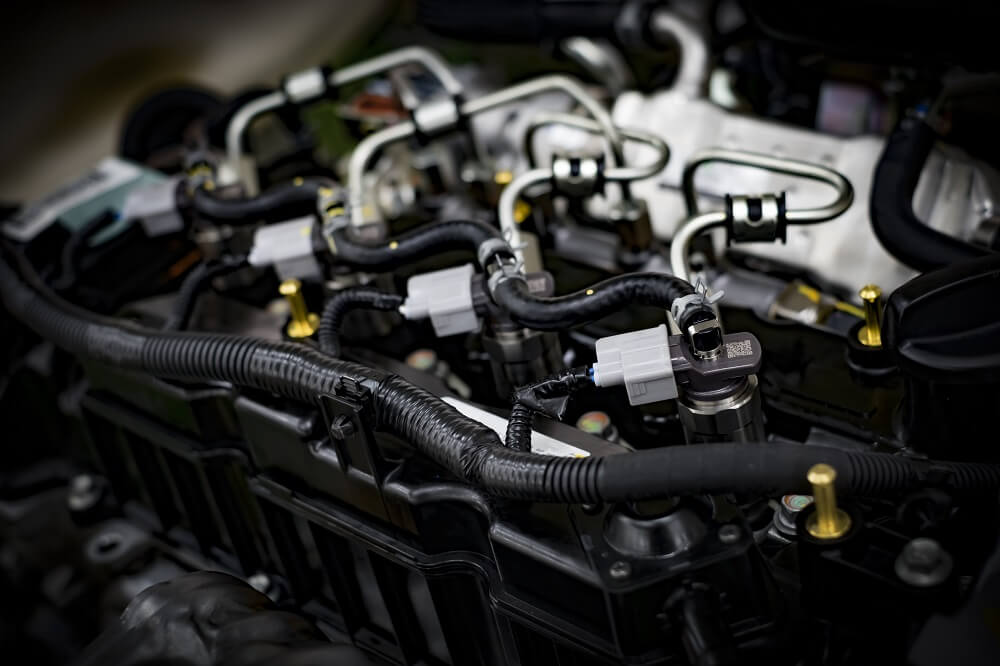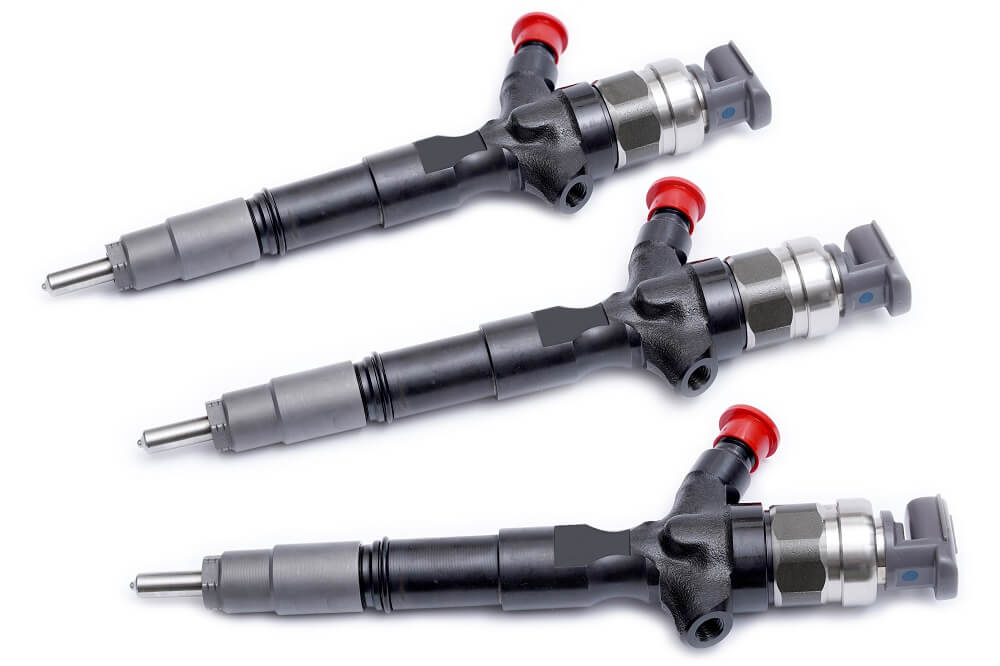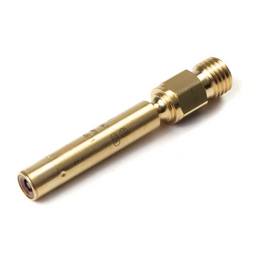Even though most people consider the engine the heart of every car, we can go much deeper than that. Engines consist of various systems, each one performing a crucial task – like the fuel system. Fuel injectors are directly responsible for providing the engine with the exact amount of fuel it needs at any given moment. Unfortunately, fuel injectors can go bad after 50-100,000 miles. Testing potentially faulty injectors at home isn’t all that difficult.
In this iteration of eEuroparts.com Car Owners’ Manual, we’ll cover the basics of fuel injectors, the difference between TBI and EFI injectors, causes and signs of bad fuel injectors, how to replace them, and lastly, how to test fuel injectors.

What is a Fuel Injector, and How Does It Work?
Fuel injectors are an integral part of the fuel injection system. They are located on the intake manifold (or in the cylinder head on direct injection engines) and their function is to spray a certain amount of fuel at a precise time to ensure the engine runs smoothly. Most cars have either four, six, or eight fuel injectors that work in sync, depending on the type of fuel injection system and how many cylinders there are.
The ECU controls how much fuel will be sent to the fuel injector and the timing of this entire operation. The job of a fuel injector, aside from mere fuel delivery, is to atomize the fuel. Atomized fuel is delivered at above manifold pressure into the intake, where it mixes with rushing air, thus forming a fuel mixture.
If the injector is clogged by debris, it won’t be able to properly atomize the fuel, nor will it be able to deliver the necessary amount of fuel to the engine. Sometimes the time impulse width of the injector, or the duration of its actuation, is affected, which can also cause performance issues.
SEARCH CATALOGWhat Causes Fuel Injector Failure?
There are a couple of things that can cause fuel injection failure, but the most common cause is poor fuel quality. Even the highest-quality fuel contains impurities that are introduced to the fuel during transport or storage. Additionally, your fuel pump picks up things from the bottom of your fuel tank from as you drive your car, which will also introduce debris to the fuel system. Depending on how much debris there is, it could cause the fuel injectors to clog up after a while.
When it comes to removing debris from fuel injectors, it can be done. However, it only makes sense to clean injectors if there’s no additional damage done.
Another common cause for fuel injector failure is residue coming from the combustion chamber. This most commonly happens with cars that are driven for short trips. This is due to evaporation from the fuel which can build up into deposits.
Lastly, mechanical damage can cause fuel injector failure. If you can clearly smell fuel when the car is running, it’s a sign that one or more fuel injectors are leaking. A damaged O-ring can be a possible cause, but also a crack in the fuel injector itself. If this is the case, you’ll need to replace all the fuel injectors.
TBI vs EFI Injectors – What’s the Difference

There are generally two common types of fuel injectors — TBI, which stands for “throttle body injection”, and EFI, which stands for “electronic fuel injection”.
The biggest difference between TBI and EFI injectors is the fact that engines with TBI injection have one or two injectors that deliver fuel via the throttle body while EFI systems feature dedicated injectors for individual cylinders that are located much closer to the intake valves. TBI is an older design that is much closer to an electronically managed carburetor than anything else.
If you drive a car made within the past several decades, there’s a good chance your engine features an EFI system.
Signs of a Bad Fuel Injector
Most commonly, fuel injectors suffer from mechanical damage caused by fuel impurities. There are a couple of signs to look for if you’re suspecting bad fuel injectors. These include starting issues, decreased performance, increased fuel consumption, rough idling, misfire, and a few other symptoms.
Starting Issues
Starting issues occur when one or more fuel injectors are partially blocked and can’t provide enough fuel when you turn the key. The car will likely start, but if your injectors are playing up, it’s almost certain that you’ll notice more symptoms than just this.
Rough Idling or Misfire
A rough idle is one of the most common symptoms of a bad fuel injector. We know what the function of the fuel injector is, so if there’s a difference between the required amount of fuel and the delivered amount of fuel, the engine will idle roughly.
More or less fuel delivered to the engine than required also causes misfire in the engine.
Decreased Performance
Acceleration is all about getting enough fuel and air into a cylinder with precise timing. If your injectors are out of spec, this simply won’t be possible. Cars with faulty fuel injectors generally have issues accelerating, their power output suffers and the overall performance of the car goes down.
Increased Fuel Consumption
Aside from symptoms shown by the engine, you’ll likely notice you’re visiting the gas station more often as well. Even when one fuel injector is bad, there’s unused fuel, and there’s additional fuel used to compensate for the lack of fuel on one cylinder.
How to Test Fuel Injectors at Home?

After noticing one or more signs of a bad fuel injector, you can test fuel injectors and see which ones are faulty and whether they can be cleaned or need replacing. Depending on the type of fuel injectors your car has, the process can be different. We’ll cover how to test fuel injectors for the types we mentioned before – TBI injectors and EFI injectors.
How To Test TBI Injectors
The process of testing TBI injectors is much easier than checking EFI injectors. You can check the spray pattern visually, and it’s much easier to reach. The process includes removing the air filter housing and making your way to the injector. You’ll need someone to crank the engine, so you can visually look at the spray pattern.
If everything is working properly, you’ll notice an upside-down V-shaped spray coming out of the TBI injector. Any kind of issue with the injector will cause it to perform out of spec. You’ll notice either that there’s no fuel coming out of it, that it’s leaking, or that the fuel is forming a single stream as it leaves the injector. If you notice any debris on the injector itself or the fuel isn’t making an upside-down V shape while leaving the injector, it’s likely you’ll be able to clean the TBI injector and return it to full condition.
How To Test EFI Injectors
Unlike throttle body injectors, EFI injectors aren’t as accessible. To check the EFI injectors, there are a few things you can do.
Before disassembling anything, use a mechanic’s stethoscope or a long screwdriver to listen for fuel injectors activating. When they open and close, injectors produce a clicking noise. This way, you’ll know if the injector is working at all. To do this, place the tip of the screwdriver on top of each fuel injector, and place your ear on the handle of the screwdriver. You’ll clearly hear a clicking noise even while the engine is running under you.
The second way to test fuel injectors is by using a multimeter and measuring the resistance on each of the injectors. Different cars have different resistance values on the fuel injectors, so checking the service manual is recommended. After setting your multimeter to the correct value, you’ll need to probe the fuel injector connector terminals and analyze the reading. This is done while the engine is turned off.
If you can’t find the manufacturer specifications, test all the fuel injectors, and most will likely have a correct reading, while a smaller number will have a lower or higher reading than the others. Differences as low as 0.5 Ohm will indicate an issue.
Why a Quality Multimeter is a Must
A multimeter is a basic tool you need to have if you want to test fuel injectors or any other electrical component of your car. It’s used to detect potential electrical issues and malfunctions, or better yet, to pinpoint the exact causes.
Owning a quality multimeter is a must whenever you’re doing any electrical diagnostic work on your car. Not only will cheapo multimeters give you readings with substantial margins of error that make them borderline useless, but some could even damage your car. There’s an unspoken rule that you shouldn’t measure the resistance on your vehicle using a multimeter that doesn’t support at least 10 megaohms of resistance.
Fortunately, most modern multimeters have a 20 megaohm setting, so you’re most likely good. However, do your due diligence and check your equipment before you start probing anything on your car. Especially if you’re using an old multimeter.
Replacing a Bad Fuel Injector
Depending on the damage, some fuel injectors can be cleaned and returned to the engine. However, in some cases, the injector must be replaced. It’s recommended to clean or replace all the injectors even if only one is faulty. This is important because the condition of one fuel injector is likely to be the same as the other injectors. If one injector doesn’t provide the spray pattern it should, it’s likely other fuel injectors will follow shortly.
There are various options available on the market regarding new fuel injectors. There are OEM fuel injectors that are usually much more expensive than aftermarket alternatives, but for a good reason. OEM fuel injectors are made from quality material and pass strict quality controls. This makes them less prone to issues and far more reliable overall.
If low-quality fuel injectors are used, it can be the same as driving with faulty fuel injectors. It can lead to catastrophic engine damage that will be much more expensive than ordering high-quality injectors in the first place.
When you test fuel injectors from your car and decide you need new ones, stick to reputable brands such as Bosch. There is a reason why many of the older Mercedes-Benz run Bosch 62274 injectors. Sure, these systems were simpler than modern ones, but Bosch has carried over that same level of quality to the latest and greatest in fuel injection technology.
That being said Bosch isn’t the only reputable brand out there. There are also Denso, Delphi, AC Delco, and many others.
Quality Parts Offer Optimal Performance
It’s important to do regular maintenance on your car if you want it to be as reliable as possible. Some parts of the car require replacing more often than others, but when the time comes, it’s essential to know which part groups require OEM or high-quality alternative replacement parts.
To make things easier for owners of European cars, only the highest-quality genuine, OEM, and aftermarket fuel injectors are available at our store. By choosing the year, make, and model in the car selection tool on our website, you’ll find a list of parts that are perfectly compatible with your car. This way, you don’t need to worry about fitment or performance once you replace the parts.




